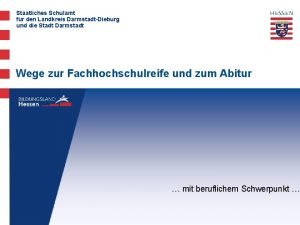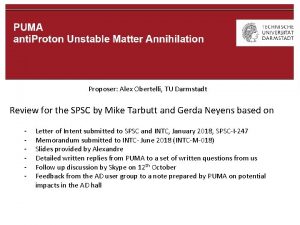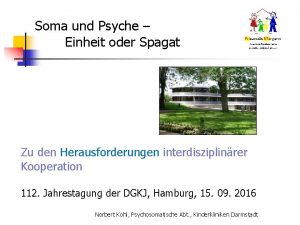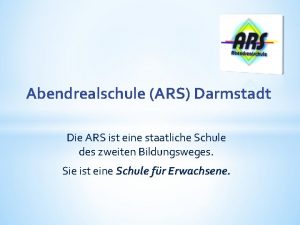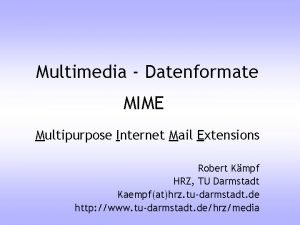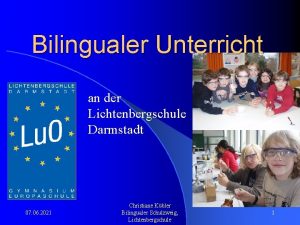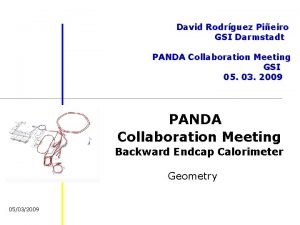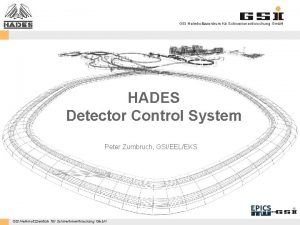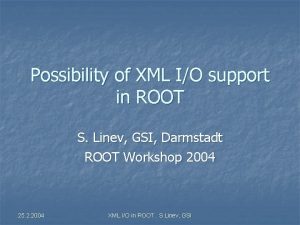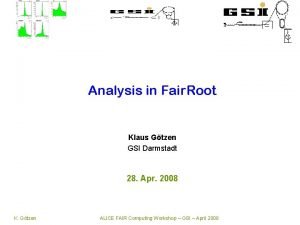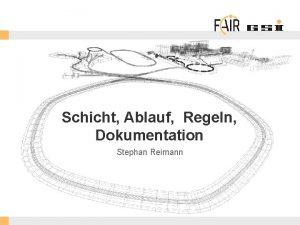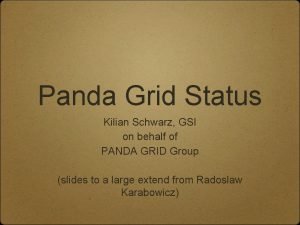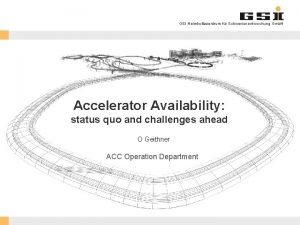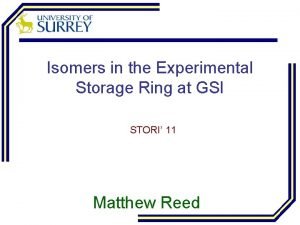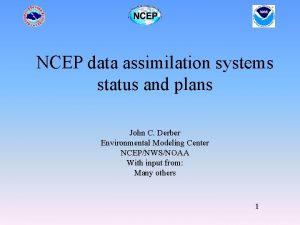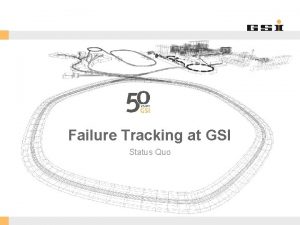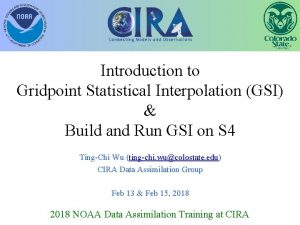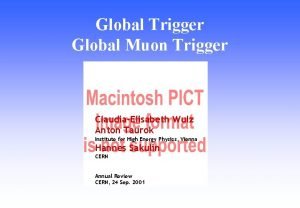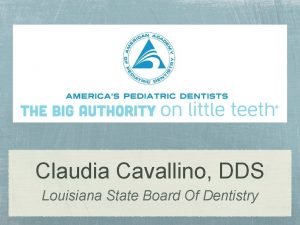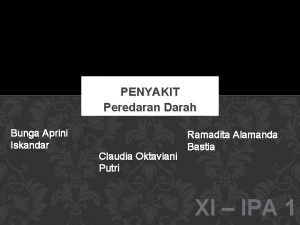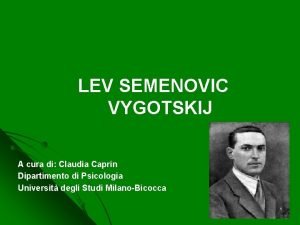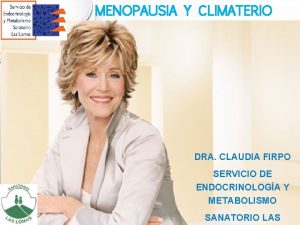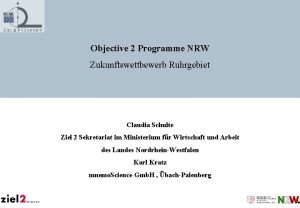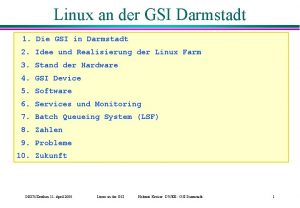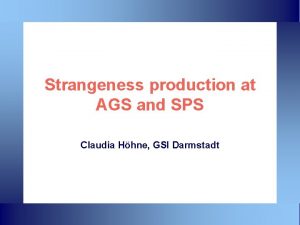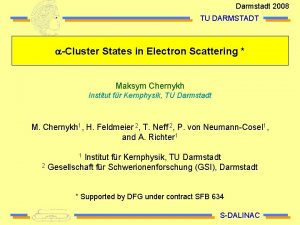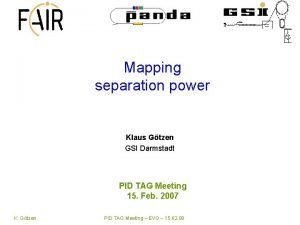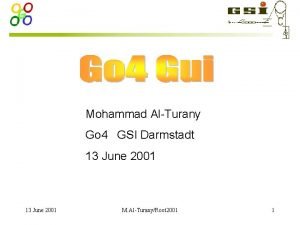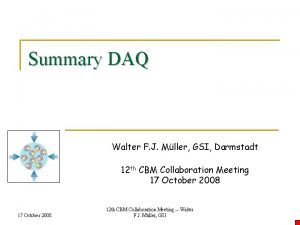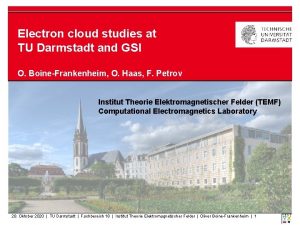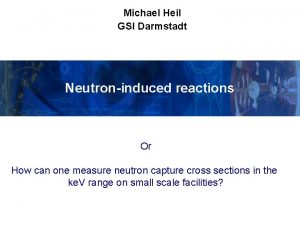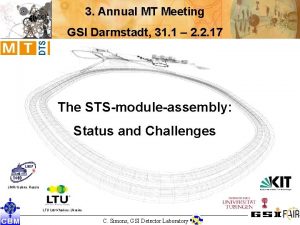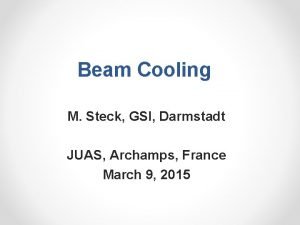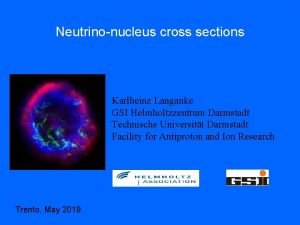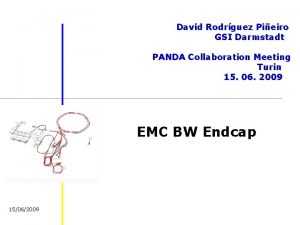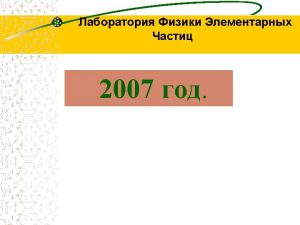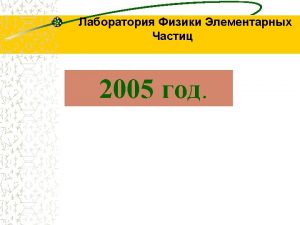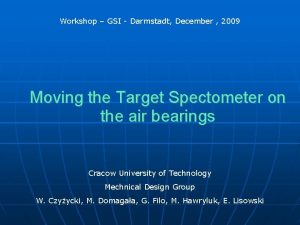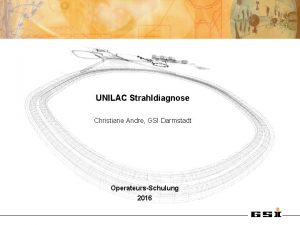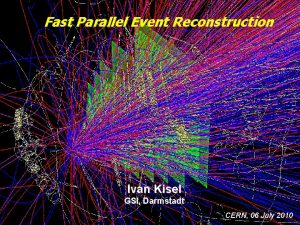Results from NA 49 Claudia Hhne GSI Darmstadt






![158 AGe. V fluctuations vs centrality [NA 49, PRC 70, 034902 (2004)] all negatives, 158 AGe. V fluctuations vs centrality [NA 49, PRC 70, 034902 (2004)] all negatives,](https://slidetodoc.com/presentation_image_h/c834e1a194a499f5a82e33f4091e4c51/image-7.jpg)



























- Slides: 34

Results from NA 49 Claudia Höhne, GSI Darmstadt for the NA 49 collaboration (CERN)

NA 49 data • comprehensive set of data on hadron production in A+A collisions (data taking period 1994 -2002, analysis still going on!) • most extensively studied at the top SPS energy for central Pb+Pb, centrality controlled peripheral Pb+Pb, Si+Si, C+C, and p+p • energy dependence over the entire SPS energy range nearly continuous energy dependence between threshold and RHIC available SPS energy range is a very interesting region! main observables: • hadron production, in particular strange hadrons • 2 -particle and charge correlations parallel talks: • collective flow A. László, Aug. 5 th, session 1 a: High-pt spectra of identified particles • fluctuations G. Stefanek, Aug. 5 th, session 2 a: Elliptic flow of L hyperons • d and d production posters • high-pt phenomena • G. Melkumov, V. Kolesnikov: Antideuteron and deuteron production • G. Melkumov, V. Kolesnikov: Antiproton and proton production • P. Dinkelaker: System-size dependence of s-production Claudia Höhne Quark Matter 2005 2

The NA 49 experiment large acceptance hadron spectrometer at the CERN-SPS beam forward hemisphere covered: (y, pt)-spectra 4 yields particle identification • d. E/dx (3 -6% res. ) • TOF (60 ps res. ) around midrapidity • invariant mass + topology (5 -10 Me. V res. ) Claudia Höhne • energy of projectile spectators measured for centrality selection • fragmentation beam for smaller nuclei Quark Matter 2005 3

158 AGe. V Hadron production in central Pb. Pb • initial stage: energy density e 3 Ge. V/fm 3 [NA 49, PRL 75, 3814 (1995)] • final state hadron yields: chemically equilibrated hadron gas • freeze-out conditions: Tchem 160 Me. V m. B 240 Me. V (gs 0. 8) • RHIC: Tchem 160 Me. V m. B 30 -50 Me. V hadronization close to predicted phase boundary! deconfined system prior to freeze-out? [Becattini et al. , PRC 69, 024905 (2004)] Claudia Höhne larger m. B at SPS compared to RHIC Quark Matter 2005 4

158 AGe. V p and p production vs centrality • protons at midrapidity: increased stopping for central collisions • antiprotons: increasing absorption? ! NA 49 preliminary stat. errors only → NA 49 poster Claudia Höhne Quark Matter 2005 5

158 AGe. V s-production vs system-size • fast increase for small systems, saturation from Npart > 60 on! quantitatively in disagreement with thermal models assuming V=V 0·Npart/2 [NA 49, PRL 94, 052301 (2005)] percolation calculation with refined volume allowing for several smaller clusters in small systems: ok! [Höhne et al. , hep-ph/0507276] lines to guide the eye similar results at RHIC, e. g. [PHENIX, PRC 69, 034909 (2004)] Claudia Höhne Quark Matter 2005 6
![158 AGe V fluctuations vs centrality NA 49 PRC 70 034902 2004 all negatives 158 AGe. V fluctuations vs centrality [NA 49, PRC 70, 034902 (2004)] all negatives,](https://slidetodoc.com/presentation_image_h/c834e1a194a499f5a82e33f4091e4c51/image-7.jpg)
158 AGe. V fluctuations vs centrality [NA 49, PRC 70, 034902 (2004)] all negatives, acceptance: 4 < y < 5. 5 and 0. 005 < pt < 1. 5 Ge. V/c NA 49 preliminary • fluctuations increase towards peripheral collisions • consistent with percolation picture: fluctuations expected for systems where several clusters are present [Ferreiro et al. , PRC 69, 034901 (2004)] • <pt> and multiplicity fluctuations correlated [Mrowczynski et al, PRC 70, 054906 (2004)] similar results at RHIC, e. g. [PHENIX, PRL 93, 092301 (2004)] Claudia Höhne Quark Matter 2005 7

158 AGe. V balance function vs centrality • analysis of balance function (all charged particles): consistent with delayed hadronization in central Pb+Pb [NA 49, PRC 71, 034903 (2005)] • new: effect of decreasing width located at mid-pseudorapidity NA 49 preliminary midrapidity: 2. 5 < h < 3. 9 0. 005 < pt < 1. 5 Ge. V/c Claudia Höhne NA 49 preliminary forward: 4 < h < 5. 4 similar results at RHIC, [STAR, PRL 90, 172301 (2003)] Quark Matter 2005 8

158 AGe. V Summary: Pb. Pb @ 158 AGe. V • central Pb. Pb: fireball of high energy density created hadron yields successfully described by hadron gas models → chem. freeze-out close to phase boundary • smaller A/ peripheral Pb. Pb: features can be explained assuming smaller/ several such sources, earlier freeze-out (not shown: consistent with results from kinetic and chemical freeze-out analysis) • created matter shows similar behaviour at top-SPS and RHIC energies • further similarities: substantial elliptic flow ( , p, L) high-pt phenomena see NA 49 talks on L-flow, and hadron production at high pt go down in energy and look for changes! Claudia Höhne Quark Matter 2005 9

158 AGe. V Highlights on L-flow and high-pt • saturation of RCP for high pt • baryon – meson difference substantial elliptic flow of L dotted line: p. QCD calculation A. László, Aug. 5 th, session 1 a G. Stefanek, Aug. 5 th, session 2 a Claudia Höhne Quark Matter 2005 10

energy scan Phase diagram hadron production measured from 20 -158 AGe. V → (T, m. B) for hadrochemical freeze-out • deconfinement reached for top-SPS and RHIC? • lower SPS energies • decreasing temperature increasing baryon density • (depart from phase boundary) Claudia Höhne [Critical point (E): Fodor and Katz, Hadron gas (gs): J. Manninen et al. , grey band: 1 st order phase transition] Quark Matter 2005 11

energy scan (Anti-)baryon production • strongly decreasing ratio increasing baryon density! • puzzle: ratio > 1 strong p absorption? → NA 49 poster (gs) [Lines: Hadron Gas (gs) J. Manninen et al. Fit to 4 data!] Claudia Höhne [Hadron Gas (gs): J. Manninen et al. Hadron Gas: K. Redlich et al. ] Quark Matter 2005 12

energy scan s-quark carriers: s-production energy dependence of s-production weakens at ~30 AGe. V K- , K 0 L (incl. S 0) X, W S± s-quark carriers: K+ , K 0 L (incl. S 0) X, W S± measured (at least partially) extrapolated (isospin symmetry (K), hadron gas model (X, W), empirical factor (S±)) Claudia Höhne Quark Matter 2005 13

energy scan relative s-production maximum in relative strangeness production at ~30 AGe. V saturation for higher energies • not explained by hadron gas models although the general feature is captured (baryon → meson dominated system) • neither by Ur. QMD, HSD [E. L. Bratkovskaya et al. , PRC 69, 054907 (2004)] • predicted for a phase transition [Gazdzicki, Gorenstein, Acta. Phys. Polon. B 30, 2705 (1999)] Redlich priv. com. , Hadron Gas, gs=1 Gazdzicki and Gorenstein Claudia Höhne Quark Matter 2005 14

energy scan Transverse-mass spectra energy dependence of mt changes at lower SPS energies seen for pions, kaons, protons and their antiparticles filled symbol: particle open symbol: antiparticle Claudia Höhne Quark Matter 2005 15

energy scan Transverse-mass spectra (II) T* inverse slope parameter of kaon pt-spectra • consistent with assuming a 1 st order phase transition: change of EOS? [Van Hove, PLB 118, 138 (1982); Gorenstein et al. , PLB 567, 175 (2003)] • not explainable by rescattering, Cronin effect from transport models data (Ur. QMD, HSD, not shown) hydro calculation [Bratkovskaya et al. , PRC 69, 054907 (2004)] [Y. Hama et al. , Braz. J. Phys. 34, 322 (2004)] Claudia Höhne Quark Matter 2005 16

energy scan Balance function all charged particles at midrapidity • decreasing width of BF → delayed hadronization with increasing energy? NA 49 preliminary • be careful: different acceptance/ phase space window for different energies, in particular for STAR! → increase of W corresponds to decreasing width of the BF [STAR, PRL 90, 172301 (2003)] Claudia Höhne Quark Matter 2005 17

energy scan (anti-)protons and (anti-)deuterons baryons: • coalescence analysis for d and supports continuously increasing coherence volume towards higher energies NA 49 preliminary d d → NA 49 poster Claudia Höhne Quark Matter 2005 18

Summary • Pb+Pb collisions at 158 AGe. V • central Pb. Pb: fireball with high energy density created chem. freeze-out close to phase boundary • smaller A/ peripheral Pb. Pb: behaviour consistent with assuming smaller/ several such sources, earlier freeze-out • created matter shows similar behaviour at top-SPS and RHIC energies (see also results on flow and high-pt phenomena) • energy dependence of central Pb+Pb collisions: 20, 30, 40, 80, 158 AGe. V • distinct changes with energy: maximum of relative strangeness production at ~30 AGe. V change of transverse expansion in SPS range • partially a result of the decrease of baryon density with energy • in detail best explained by models assuming explicitly a transition to a deconfined state at higher energy onset of deconfinement at lower SPS energies Claudia Höhne Quark Matter 2005 19

NA 49 collaboration C. Alt, T. Anticic, B. Baatar, D. Barna, J. Bartke, L. Betev, H. Bialkowska, C. Blume, B. Boimska, M. Botje, J. Bracinik, R. Bramm, P. Buncic, V. Cerny, P. Christakoglou, O. Chvala , J. G. Cramer, P. Csató, P. Dinkelaker, V. Eckardt, D. Flierl, Z. Fodor, P. Foka, V. Friese, J. Gál, M. Gazdzicki, V. Genchev , G. Georgopoulos, E. Gladysz, K. Grebieszkow, S. Hegyi, C. Höhne, K. Kadija, A. Karev, M. Kliemant, S. Kniege, V. I. Kolesnikov, E. Kornas, R. Korus, M. Kowalski, I. Kraus, M. Kreps, A. Laszlo, M. van Leeuwen, P. Lévai, L. Litov, B. Lungwitz, M. Makariev, A. I. Malakhov, M. Mateev, G. L. Melkumov, M. Mitrovski, J. Molnár, St. Mrówczynski, V. Nicolic, G. Pálla, A. D. Panagiotou, D. Panayotov, A. Petridis, M. Pikna, D. Prindle, F. Pühlhofer, R. Renfordt, C. Roland, G. Roland, M. Rybczynski, A. Rybicki, A. Sandoval, N. Schmitz, T. Schuster, P. Seyboth, F. Siklér, B. Sitar, E. Skrzypczak, G. Stefanek , R. Stock, C. Strabel, H. Ströbele, T. Susa, I. Szentpétery, J. Sziklai, P. Szymanski, V. Trubnikov, D. Varga, M. Vassiliou, G. I. Veres, G. Vesztergombi, D. Vranic, A. Wetzler, Z. Wlodarczyk, I. K. Yoo, J. Zimányi NIKHEF, Amsterdam, Netherlands. Department of Physics, University of Athens, Greece. Comenius University, Bratislava, Slovakia. KFKI Research Institute for Particle and Nuclear Physics, Budapest, Hungary. MIT, Cambridge, USA. Institute of Nuclear Physics, Cracow, Poland. Gesellschaft für Schwerionenforschung (GSI), Darmstadt, Germany. Joint Institute for Nuclear Research, Dubna, Russia. Fachbereich Physik der Universität, Frankfurt, Germany. CERN, Geneva, Switzerland. Institute of Physics Swietokrzyska Academy, Kielce, Poland. Fachbereich Physik der Universität, Marburg, Germany. Max-Planck-Institut für Physik, Munich, Germany. Institute of Particle and Nuclear Physics, Charles University, Prague, Czech Republic. Department of Physics, Pusan National University, Pusan, Republic of Korea. Nuclear Physics Laboratory, University of Washington, Seattle, WA, USA. Atomic Physics Department, Sofia University St. Kliment Ohridski, Sofia, Bulgaria. Institute for Nuclear Research and Nuclear Energy, Sofia, Bulgaria. Institute for Nuclear Studies, Warsaw, Poland. Institute for Experimental Physics, University of Warsaw, Poland. Rudjer Boskovic Institute, Zagreb, Croatia. Claudia Höhne Quark Matter 2005 parallel talks: A. László, Aug. 5 th, session 1 a High-pt spectra of identified particles G. Stefanek, Aug. 5 th, session 2 a Elliptic flow of L hyperons posters G. Melkumov, V. Kolesnikov, session 1 • Antideuteron and deuteron production • Antiproton and proton production P. Dinkelaker, session 2 System-size dependence of s-production 20

backup slides Claudia Höhne Quark Matter 2005 21

Data • wealth of data collected! (data taking period from 1994 – 2002) • analysis still ongoing, more to come! • large statistics samples at top-SPS energy • centrality dependence and system-size dependence for 40 and 158 AGe. V • energy scan from 20 – 158 AGe. V • pp, p. A data for comparison (not shown in table) Claudia Höhne energy system centrality statistics 158 AGe. V Pb. Pb 10%, 23% 800 k, 3000 k minimum bias 410 k CC, Si. Si 15%, 12% 220 k, 300 k 80 AGe. V Pb. Pb 7% 300 k 40 AGe. V Pb. Pb 7% 700 k minimum bias 430 k CC, Si. Si 66%, 29% 240 k, 130 k 30 AGe. V Pb. Pb 7%, 35% 440 k, 230 k 20 AGe. V Pb. Pb 7%, 35% 360 k, 330 k Quark Matter 2005 22

energy scan pt-spectra 30 AGe. V Claudia Höhne 20 AGe. V Quark Matter 2005 23

energy scan rapidity distributions Central Pb+Pb 7% (20 -80 AGe. V) 5/10% (158 AGe. V) NA 49 Claudia Höhne Quark Matter 2005 24

hadron production energy scan • (y, pt)-spectra for large variety of hadrons measured from 20 -158 AGe. V AGS NA 49 BRAHMS still adding data: • X and • K 0 S • QM: ratio at midrapidity p, d, at midrapidity central Au+Au, Pb+Pb 4 rapidities only Claudia Höhne Quark Matter 2005 25

energy scan p-production energy dependence of production strengthens at ~30 AGe. V Claudia Höhne Quark Matter 2005 26

energy scan particle ratios: strangeness maximum of relative strangeness production at ~30 AGe. V Claudia Höhne Quark Matter 2005 27

energy scan particle ratios: strangeness (II) • Ur. QMD, HSD [E. L. Bratkovskaya et al. , PRC 69, 054907 (2004)] • Hadron Gas [P. Braun-Munzinger et al. , NPA 697, 902 (2002)] • Hadron Gas (gs) [F. Becattini et al. , PRC 69, 024905 (2004)] • general features captured by models (baryon → meson dominated systems) • models fail to describe the data in detail • predicted for a phase transition [Gazdzicki, Gorenstein, Acta. Phys. Polon. B 30, 2705 (1999)] Claudia Höhne Quark Matter 2005 28

energy scan Transverse-mass spectra (II) • not explainable with transport models: rescattering, Cronin effect • consistent with assuming a 1 st order phase transition: change of EOS? [Van Hove, PLB 118, 138 (1982); Gorenstein et al. , PLB 567, 175 (2003)] [Bratkovskaya et al. , PRC 69, 054907 (2004)] Claudia Höhne [Y. Hama et al. , Braz. J. Phys. 34, 322 (2004)] Quark Matter 2005 29

energy scan HBT analysis for negative pions • pt-spectra can be consistenly described together with results from --HBT analysis using an advanced "blast-wave parametrization", e. g. [Retiere and Lisa, PRC 70, 044907 (2004)] • freeze-out conditions (radii, time, emission duration) similar at the higher energies → no strong change in freeze-out volume for pions seen Claudia Höhne Quark Matter 2005 30

particle identification momentum d. E/dx . . . + topology Claudia Höhne . . . + TOF Quark Matter 2005 31

NA 49 published papers • SYSTEM SIZE AND CENTRALITY DEPENDENCE OF THE BALANCE FUNCTION IN A + A COLLISIONS AT S(NN)**(1/2) = 17. 2 -GEV, Phys. Rev. C 71: 034903, 2005 • OMEGA- AND ANTI-OMEGA+ PRODUCTION IN CENTRAL PB + PB COLLISIONS AT 40 -AGEV AND 158 -AGEV, Phys. Rev. Lett. 94: 192301, 2005 • SYSTEM-SIZE DEPENDENCE OF STRANGENESS PRODUCTION IN NUCLEUS COLLISIONS AT S(NN)**(1/2) = 17. 3 -GEV, Phys. Rev. Lett. 94: 052301, 2005 • ELECTRIC CHARGE FLUCTUATIONS IN CENTRAL PB+PB COLLISIONS AT 20 -AGEV, 30 -A-GEV, 40 -A-GEV, 80 -A-GEV, AND 158 -A-GEV, Phys. Rev. C 70: 064903, 2004 • LAMBDA AND ANTI-LAMBDA PRODUCTION IN CENTRAL PB - PB COLLISIONS AT 40 -A-GEV, 80 -A-GEV AND 158 -A-GEV, Phys. Rev. Lett. 93: 022302, 2004 • TRANSVERSE MOMENTUM FLUCTUATIONS IN NUCLEAR COLLISIONS AT 158 -AGEV, Phys. Rev. C 70: 034902, 2004 • OBSERVATION OF AN EXOTIC S = -2, Q = -2 BARYON RESONANCE IN PROTON COLLISIONS AT THE CERN SPS, Phys. Rev. Lett. 92: 042003, 2004 • ENERGY AND CENTRALITY DEPENDENCE OF DEUTERON AND PROTON PRODUCTION IN PB + PB COLLISIONS AT RELATIVISTIC ENERGIES, Phys. Rev. C 69, 024902 (2004) Claudia Höhne Quark Matter 2005 32

NA 49 published papers (II) • DIRECTED AND ELLIPTIC FLOW OF CHARGED PIONS AND PROTONS IN PB + PB COLLISIONS AT 40 -A-GEV AND 158 -A-GEV, Phys. Rev. C 68: 034903, 2003 • BOSE-EINSTEIN CORRELATIONS OF CHARGED KAONS IN CENTRAL PB+PB COLLISIONS AT EBEAM=158 GEV PER NUCLEON, Phys. Lett. B 557: 157 -166, 2003 • ENERGY DEPENDENCE OF PION AND KAON PRODUCTION IN CENTRAL PB + PB COLLISIONS, Phys. Rev. C 66: 054902, 2002 • CASCADE AND ANTI-CASCADE+ PRODUCTION IN CENTRAL PB + PB COLLISIONS AT 158 -GEV/C PER NUCLEON, Phys. Lett. B 538: 275 -281, 2002 • EVENT-BY-EVENT FLUCTUATIONS OF THE KAON TO PION RATIO IN CENTRAL PB + PB COLLISIONS AT 158 -GEV PER NUCLEON, Phys. Rev. Lett. 86: 1965 -1969, 2001 • PRODUCTION OF PHI MESONS IN P + P, P + PB AND CENTRAL PB + PB COLLISIONS AT E(BEAM) = 158 -A-GEV, Phys. Lett. B 491: 59 -66, 2000 • DEUTERON PRODUCTION IN CENTRAL PB + PB COLLISIONS AT 158 -A-GEV, Phys. Lett. B 486: 22 -28, 2000 • TWO PROTON CORRELATIONS FROM 158 -A-GEV PB + PB CENTRAL COLLISIONS, Phys. Lett. B 467: 21 -28, 1999 Claudia Höhne Quark Matter 2005 33

NA 49 published papers (III) • EVENT-BY-EVENT FLUCTUATIONS OF AVERAGE TRANSVERSE MOMENTUM IN CENTRAL PB + PB COLLISIONS AT 158 -GEV PER NUCLEON, Phys. Lett. B 459: 679686, 1999 • THE NA 49 LARGE ACCEPTANCE HADRON DETECTOR, Nucl. Instrum. Meth. A 430: 210244, 1999 • BARYON STOPPING AND CHARGED PARTICLE DISTRIBUTIONS IN CENTRAL PB + PB COLLISIONS AT 158 -GEV PER NUCLEON, Phys. Rev. Lett. 82: 2471 -2475, 1999 • XI AND ANTI-XI PRODUCTION IN 158 -GEV / NUCLEON PB + PB COLLISIONS, Phys. Lett. B 444: 523 -530, 1998 • SPECTATOR NUCLEONS IN PB + PB COLLISIONS AT 158 -A-GEV, Eur. Phys. J. A 2: 383 -390, 1998 • HADRONIC EXPANSION DYNAMICS IN CENTRAL PB + PB COLLISIONS AT 158 -GEV PER NUCLEON, Eur. Phys. J. C 2: 661 -670, 1998 • DIRECTED AND ELLIPTIC FLOW IN 158 -GEV / NUCLEON PB + PB COLLISIONS, Phys. Rev. Lett. 80: 4136 -4140, 1998 • TRANSVERSE ENERGY PRODUCTION IN PB-208 + PB COLLISIONS AT 158 -GEV PER NUCLEON, Phys. Rev. Lett. 75: 3814 -3817, 1995 • THE NA 49 DATA ACQUISITION SYSTEM, IEEE Trans. Nucl. Sci. 41: 30, 1994 Claudia Höhne Quark Matter 2005 34
 Berufliches gymnasium dieburg
Berufliches gymnasium dieburg Darmstadt alex
Darmstadt alex Sondenentwöhnung darmstadt
Sondenentwöhnung darmstadt Abendrealschule darmstadt
Abendrealschule darmstadt Straßenverkehrsamt darmstadt parkausweis
Straßenverkehrsamt darmstadt parkausweis Extensions darmstadt
Extensions darmstadt Darmstadt madonna
Darmstadt madonna Lichtenbergschule darmstadt
Lichtenbergschule darmstadt Pixel gsi
Pixel gsi Panda collaboration meeting
Panda collaboration meeting Hades gsi
Hades gsi Gsi parser
Gsi parser Arthus reakció
Arthus reakció Calendrier académique bari
Calendrier académique bari Gsi root
Gsi root Dokumentation schichtübergabe
Dokumentation schichtübergabe Maud preher
Maud preher Kilian schwarz
Kilian schwarz Gsi beamtime schedule
Gsi beamtime schedule Gsi
Gsi Slope height
Slope height Ncep model status
Ncep model status Olog gsi
Olog gsi Gridpoint statistical interpolation
Gridpoint statistical interpolation Claudia surjadjaja
Claudia surjadjaja Claudia koll basilio colacione
Claudia koll basilio colacione Claudia dommaschk
Claudia dommaschk Claudia sapena
Claudia sapena Claudia wulz
Claudia wulz Claudia cavallino
Claudia cavallino Thank you note to building superintendent
Thank you note to building superintendent Embulus
Embulus Claudia caprin
Claudia caprin Síntomas de menopausia a los 40
Síntomas de menopausia a los 40 Claudia schulte
Claudia schulte
